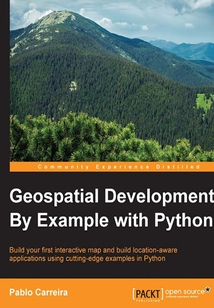舉報 

會員
Geospatial Development By Example with Python
最新章節(jié):
Index
GeospatialDevelopmentByExamplewithPythonisintendedforbeginnersoradvanceddevelopersinPythonwhowanttoworkwithgeographicdata.Thebookissuitableforprofessionaldeveloperswhoarenewtogeospatialdevelopment,forhobbyists,orfordatascientistswhowanttomoveintosomesimpledevelopment.
目錄(93章)
倒序
- 封面
- 版權(quán)頁
- Credits
- About the Author
- About the Reviewers
- www.PacktPub.com
- Support files eBooks discount offers and more
- Preface
- What this book covers
- What you need for this book
- Who this book is for
- Conventions
- Reader feedback
- Customer support
- Chapter 1. Preparing the Work Environment
- Installing Python
- Python packages and package manager
- Installing packages and required software
- Installing NumPy
- Installing GDAL and OGR
- Installing Mapnik
- Installing Shapely
- Installing other packages directly from pip
- Installing an IDE
- Creating the book project
- Programming and running your first example
- Transforming the coordinate system and calculating the area of all countries
- Sort the countries by area size
- Summary
- Chapter 2. The Geocaching App
- Building the basic application structure
- Downloading geocaching data
- Opening the file and getting its contents
- Combining functions into an application
- Setting your current location
- Finding the closest point
- Summary
- Chapter 3. Combining Multiple Data Sources
- Representing geographic data
- Making data homogeneous
- Importing geocaching data
- Integrating new functionality into the application
- Summary
- Chapter 4. Improving the App Search Capabilities
- Working with polygons
- Using Shapely to handle geometries
- Importing polygons
- Getting the attributes' values
- Importing lines
- Converting the spatial reference system and units
- Geometry relationships
- Filtering by attributes and relations
- Filtering by multiple attributes
- Integrating with the app
- Summary
- Chapter 5. Making Maps
- Knowing Mapnik
- Creating utility functions to generate maps
- Styling maps
- Using Python objects as a source of data
- Exporting geo objects
- Creating the Map Maker app
- Summary
- Chapter 6. Working with Remote Sensing Images
- Understanding how images are represented
- Processing remote sensing images and data
- Building an image processing pipeline
- Summary
- Chapter 7. Extract Information from Raster Data
- Getting the basic statistics
- Creating color classified images
- Blending images
- Showing statistics with colors
- Summary
- Chapter 8. Data Miner App
- Measuring execution time
- Code profiling
- Storing information on a database
- Importing massive amount of data
- Searching for data and crossing information
- Summary
- Chapter 9. Processing Big Images
- Working with satellite images
- Memory and images
- Processing images in chunks
- Creating image compositions
- Summary
- Chapter 10. Parallel Processing
- Multiprocessing basics
- Block iteration
- Improving the image resolution
- Summary
- Index 更新時間:2021-07-16 09:31:16
推薦閱讀
- Building a Home Security System with Raspberry Pi
- iOS開發(fā)實戰(zhàn):從零基礎(chǔ)到App Store上架
- PHP+MySQL網(wǎng)站開發(fā)技術(shù)項目式教程(第2版)
- Python 3破冰人工智能:從入門到實戰(zhàn)
- Mastering macOS Programming
- Mastering Google App Engine
- Access 2010數(shù)據(jù)庫應(yīng)用技術(shù)(第2版)
- Swift 4 Protocol-Oriented Programming(Third Edition)
- 零基礎(chǔ)學(xué)Kotlin之Android項目開發(fā)實戰(zhàn)
- JavaScript應(yīng)用開發(fā)實踐指南
- Java 從入門到項目實踐(超值版)
- 大學(xué)計算機基礎(chǔ)實驗指導(dǎo)
- Keil Cx51 V7.0單片機高級語言編程與μVision2應(yīng)用實踐
- Visual C++網(wǎng)絡(luò)編程教程(Visual Studio 2010平臺)
- 你也能看得懂的Python算法書
- Python服務(wù)端測試開發(fā)實戰(zhàn)
- Flink大數(shù)據(jù)分析實戰(zhàn)
- 零基礎(chǔ)學(xué)Visual Basic第2版
- C語言開發(fā)手冊
- 圖形圖像設(shè)計與制作(第二版)
- PSYCHTOOLBOX工具箱及MATLAB編程實例
- Visual Basic 2008應(yīng)用程序開發(fā)實例精講
- 響應(yīng)式Web開發(fā)項目教程(HTML5+CSS3+Bootstrap)
- 輕松學(xué):C++語言
- 機器學(xué)習(xí)數(shù)學(xué)基礎(chǔ)一本通(Python版)
- Learning BeagleBone Python Programming
- JavaScript程序設(shè)計基礎(chǔ)教程
- Practical Data Analysis(Second Edition)
- 青少年軟件編程基礎(chǔ)與實戰(zhàn)(圖形化編程四級)
- Flutter開發(fā)實例解析

